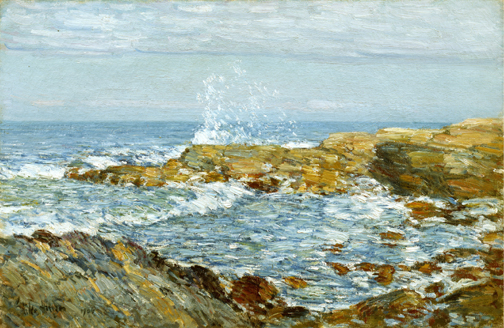 Childe Hassam was a leading American impressionist painter and printmaker. The son of a prosperous hardware merchant and antique collector, Hassam (christened Frederick Childe Hassam) was born in 1859 near Boston. In 1872 a great fire in Boston destroyed his father’s business, forcing Hassam to leave school. He found a job with a publishing firm, but having little talent for business, he began work as an apprentice to a wood engraver and later created illustrations for such magazines as Harper’s and The Century. Between 1877 and 1879, Hassam attended evening classes at the Boston Art Club, studied briefly with William Rimmer at the Lowell Institute, and also took private painting lessons.
Childe Hassam was a leading American impressionist painter and printmaker. The son of a prosperous hardware merchant and antique collector, Hassam (christened Frederick Childe Hassam) was born in 1859 near Boston. In 1872 a great fire in Boston destroyed his father’s business, forcing Hassam to leave school. He found a job with a publishing firm, but having little talent for business, he began work as an apprentice to a wood engraver and later created illustrations for such magazines as Harper’s and The Century. Between 1877 and 1879, Hassam attended evening classes at the Boston Art Club, studied briefly with William Rimmer at the Lowell Institute, and also took private painting lessons.
The piece above is available for custom reproduction through the Florence Griswold Museum’s RequestAPrint site.
At the age of twenty-four, Hassam visited Great Britain and the European Continent for two months. In 1886 he moved to Paris, where he studied at the conservative art school, Académie Julian. Hassam was attracted to French Impressionism, however, and readily absorbed elements of the avant-garde style. Hassam returned to the United States in 1889, moving from Boston to New York. Integrating his understanding of impressionism with his own tendency toward clear compositional structure and forms, he painted many views of the city. Noted for their light impressionist colors, quick brushstrokes, and also their solidity, his city views were well received, and he became known as one of the leading American impressionists. Hassam was able to return to Europe twice between 1897 and 1910, visiting Pont-Aven, where many Post-Impressionists had painted, and, on his last trip, southern Spain. In late 1897, he withdrew from the Society of American Artists and co-founded the Ten American Painters with fellow American Impressionists J. Alden Weirand John Twachtman.
In 1915, influenced in part by the work of his friend Weir, Hassam began experimenting with etching and, two years later, lithography. In 1920, having summered at various seaside resorts since 1882, he established a permanent summer studio in East Hampton, Long Island. During the remaining fifteen years of his life, Hassam continued to exhibit regularly, enjoying national recognition and receiving numerous awards and honors.
Visit the RequestAPrint gallery page for the featured piece to see learn more on purchasing your own reproduction of this piece and many more!
(Information Credit: phillipscollection.org)



 Mitzura Salgian is a Fine Artist with a masterful technique and reverence for detail. Her distinctive style is rooted in the Baroque richness of imagery and the Surrealist sense of marvelous to which she was drawn since her early teens. Mitzura is an American artist of Romanian origin. She was educated in her native city of Bucharest, where she received MFA from the Fine Arts Institute.
Mitzura Salgian is a Fine Artist with a masterful technique and reverence for detail. Her distinctive style is rooted in the Baroque richness of imagery and the Surrealist sense of marvelous to which she was drawn since her early teens. Mitzura is an American artist of Romanian origin. She was educated in her native city of Bucharest, where she received MFA from the Fine Arts Institute. Museum in Neenah, Wisconsin; the National Arts Club, the Salmagundi Club Galleries and the New York University Washington Square East Galleries, all in New York City; the Attleboro Arts Museum in Attleboro, Massachusetts; the Turtle Bay Museum in Redding, California; the Danville Museum of Fine Arts And History in Danville, Virginia; the Huntsville Museum of Art in Huntsville, Alabama; the Museum of Texas Tech University in Lubbock, Texas; the World Bank Auditorium in Washington, District of Columbia.
Museum in Neenah, Wisconsin; the National Arts Club, the Salmagundi Club Galleries and the New York University Washington Square East Galleries, all in New York City; the Attleboro Arts Museum in Attleboro, Massachusetts; the Turtle Bay Museum in Redding, California; the Danville Museum of Fine Arts And History in Danville, Virginia; the Huntsville Museum of Art in Huntsville, Alabama; the Museum of Texas Tech University in Lubbock, Texas; the World Bank Auditorium in Washington, District of Columbia.